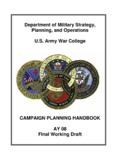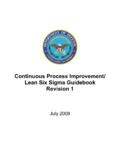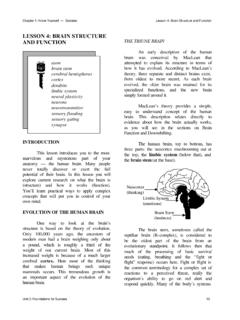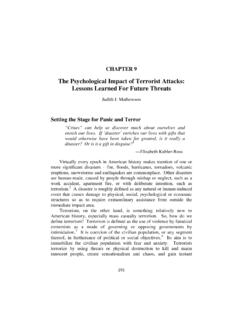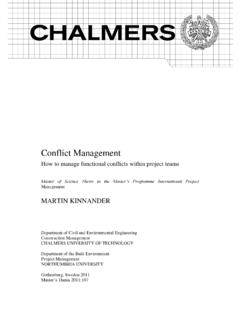Transcription of Steps in Interest-Based Negotiation Federal …
1 Steps in Interest-Based Negotiation Federal mediation and Conciliation Service Human Resources Development Canada Step 1 - Formulation of Joint Opening Statement Once the decision has been made to use the Interest-Based process and joint training has been completed, preparation for negotiations begins with the parties developing a joint opening statement of objectives for the Negotiation process. Purpose: Sets positive tone for negotiations Ensures common understanding of process Can be provided to constituents All of these may be useful since Interest-Based bargaining constitutes a departure from the parties' usual way of conducting negotiations . This and all Steps of the Interest-Based approach are based on the assumption that time spent in early, open, and explicit discussion of both process and content issues will pay dividends in fewer misunderstandings and less rigidity and entrenchment later in the process.
2 Joint statements of objectives usually contain: a good faith commitment by all parties to make a serious effort to use the Interest-Based process and to refrain from attempting to apply power to the resolution of issues a description of their understanding of Interest-Based Negotiation a statement of why they decided to use the process, including any shared, superordinate goals ( the long-term viability of the employer) Sample Joint Opening Statement: The Union and the Company plan to make every effort to negotiate the collective agreement using the Interest-Based process. They will endeavour to share information openly and participate in discussions of a range options with the understanding that no final commitments will be made until the end of the process.
3 As the parties jointly face the challenge of the future, they share the following values: client focus the overriding value of people as a resource union-management partnership quality and continuous improvement Alternatives: Each party prepares and provides to the other a separate opening statement setting out the what, how and why of their decision to use the process. This has the advantage of requiring less time and effort, but the process lacks the synergistic benefits of working through a joint statement. A joint subcommittee prepares a joint statement of objectives prior to negotiations . This maintains the jointness of the process without requiring the time and effort of the full negotiating team.
4 The joint or separate opening statements should be copied onto flip chart paper and posted in view of the group. Step 2 - Establishing Ground Rules In traditional negotiations , parties do not usually engage in much discussion about the negotiating process. Ground rules are typically used simply to establish agreement as to where, when and how frequently the parties will meet. In addition to these housekeeping matters, ground rules are used in Interest-Based bargaining to establish the process, including the new negotiating norms and the expected behaviours of individuals. The joint development of these ground rules helps ensure: Ownership of the process Commitment to the ground rules Ground rules typically cover: Physical arrangements Use of flip charts, facilitation Start and stop times, breaks Use of caucuses Record of proceedings, if any Table behaviour, such as.
5 Focus on issues, not personalities One person speaking at a time No cell phones on in meetings Treat the input of others with respect Use of subcommittees Communications Confidentiality of information shared Right to withdraw from process or revisit the ground rules The agreed to ground rules should be written on flip chart paper and posted in view of the group. All negotiators should take personal responsibility for ensuring that the ground rules are respected. Sample Ground Rules: The following ground rules were used by one Canadian union and company in their Interest-Based bargaining process. Separate, independent communication channels Advise each other of communication plans and the issues/interests to be covered No official detailed record/minutes of proceeding Periodic jointly prepared summaries based on charts and reviewed by full group Don't over-advertise (hype)
6 The Interest-Based bargaining process Options not to go beyond table Tentative agreement on issues which may be revisited if needed In special cases new issues may be brought up later Co-chairs needed for coordination/communication, with understanding of full participation of all Experts/resources to attend with advance notice if possible Review the process at intervals No smoking in meeting room Voice issues openly to full group Respectful of each other's ideas/suggestions Written handouts to be coordinated through co-chairs When sensitive, confidential information is to be shared, the following procedure will be used: the provider will state the nature of the sensitivity the parties will discuss the information and decide by consensus how it is to be handled Everyone is personally pledged to support the agreement reached Step 3 - Developing the List of Issues In preparation for traditional collective bargaining, parties normally develop lists of demands or positions, which they exchange early in the Negotiation process, thereby determining the issues or topics to be discussed.
7 In Interest-Based Negotiation , separate lists of demands are not prepared, and it is fundamental to the process that parties make a concerted effort to avoid taking a firm position on any issue in advance of bargaining. Instead, each party considers the hopes, fears, needs and concerns of its constituents and then prepares a list of issues it wants discussed in the negotiations . Once these lists of issues have been exchanged, the parties typically meet to agree on a common list for the negotiations . Lists of issue should be: Realistic - Unlike traditional negotiations , this list should not contain "throw-away" issues which are included simply to be dropped when a concession is required.
8 The list should be an honest statement of those issues which a party believes must be addressed. Open-ended - the statement should not include any positions or preferred solutions, but simply a description of the problem. It may be helpful to reframe the issue as a question to remove positions, interests, options, solutions and judgements from the statement of the issue. The question should start with an open-ended phrase such as: How can or What is the best way to . Example: Employer Issue: We need to reduce abuse of sick leave. Union Issue: We need to reward employees for good attendance. Reframed Joint Issue: What can we do to promote an improvement in attendance?
9 Suggestions for negotiating common list of issues: 1. Issues can be stated very broadly in a word or short phrase: family leave, or more specifically in a complete sentence: The challenges faced by employees attempting to balance work and family responsibilities. 2. It may be helpful to cluster issues under broader headings, with each subissue identified. 3. All issues should be clarified at this stage so that all parties have a common understanding of the problem or topic to be addressed. The party proposing the issue for inclusion should provide examples and clarify the examples. It is very important that everyone has the same definition of the issue before proceeding to the next step.
10 4. If the issue is still not clear, a joint sub-committee could be assigned the task of investigating the matter and developing background information for the plenary group. 5. The agreed to definition of each issue should be copied onto a separate sheet of flip chart paper. This will be the starting point for the discussion of each issue. Step 4 - Identification of Interests Issue: Topic or subject under discussion Position: One party's solution to an issue interest : One party's concern, fear, need or worry about an issue Positional Bargaining In traditional negotiations , positions are the primary vehicle of communication between the negotiators.

